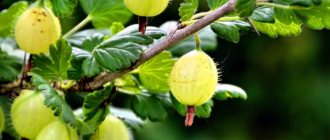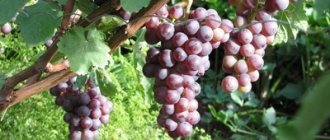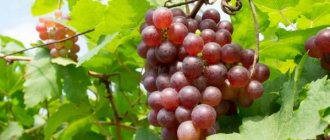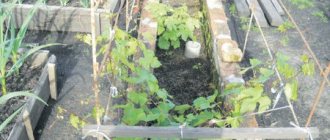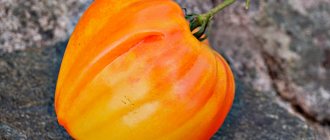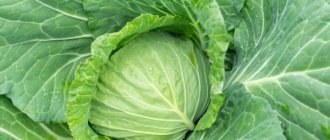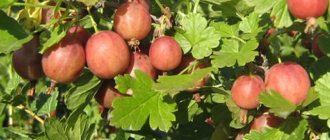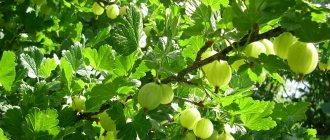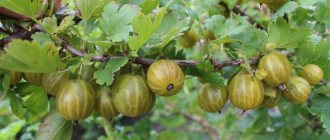History of selection
In an effort to choose from the variety of varieties of such a tasty and healthy berry as gooseberries, owners of personal plots cannot help but pay attention to the Russian Yellow variety. Most often, gooseberry fruits are green in color - from pale or transparent to deep and rich dark shades. The Russian Yellow gooseberry variety is distinguished by its golden-amber color of berries with a pleasant sourness in taste and rich aroma.
When working on developing a gooseberry variety with such qualities as ease of care, fertility, sweet, juicy berries, breeder K. D. Sergeeva at the VNIIS named after. Michurina I.V. obtained the Russian Yellow gooseberry variety in the 70s of the last century. The Russian gooseberry was taken as the basis for the work; genetic material from such varieties as Stambovy, Kareless, Oregon, and Curry was also used. In 1974, the resulting hybrid, called Russian yellow gooseberry, was included in the State Register of the Russian Federation for use in the Central regions of Russia.
Official information
The variety was created on the basis of the Russian gooseberry variety by accident and was recognized as a spontaneous mutant.
The originator and copyright holder of the variety is the Federal State Budgetary Institution " Federal Scientific Center named after. I. V. Michurina ". Tambov region, Michurinsk.
In the research spaces of this scientific institution, the “Yellow Russian” variety was born in 1964. It took 10 long years to test the variety, and in 1974 the variety was included in the register of breeding achievements under number 6402186.
Planting and caring for perennial flax in open ground, growing from seeds
Unfortunately, the variety has not been properly tested in all territorial districts and is recommended for cultivation only in the North-Western and Ural regions as an average ripening period.
Description of gooseberry variety Russian yellow
The gooseberry variety Russian Yellow was bred in 1970 at the All-Russian Research Institute of Horticulture named after I.V. Michurin through the selection of several varieties: Curry, Stambovy, Oregon, Houghton and Kareless. The distinctive features of the variety include stable annual yields, golden-yellow color of fruits and high resistance to powdery mildew. And thanks to its resistance to frost and drought, Russian yellow is suitable for growing both in the middle zone and in warmer climatic conditions.
Medium-sized bushes have a sparse crown with spreading branches. The height of an adult shrub is 1–1.3 m. Young shoots of gooseberries are green in color, much thicker than completely lignified branches, which turn brown with age. The leaves are medium-sized, bright green, slightly shiny, pubescent, leathery. The teeth on them are medium, blunt, slightly bent. There is no coloration of the main veins. The buds are brown, oblong, small, with a blunt apex. There are few thorns; they are located mainly in the root zone of the bush. The plant blooms with small pale flowers, arranged 1–2 per cluster. The ovary is bare, oval, without edges.
The bush is medium spreading, the thorniness of the shoots is weak
The fruits are large (4.5–6 g), oval, with a waxy coating, and after ripening they acquire a beautiful golden hue. The taste of the berries is sweet and sour, with juicy pulp and a small number of seeds. The skin is of medium thickness, with strong veining. The veins are slightly branched, lighter than the main color of the fruit.
Chemical composition of fruits:
- total sugars - 9.3%;
- titratable acids - 2.1%;
- ascorbic acid - 12.0–32.0 mg per 100 g.
The berries are large, oval or pear-shaped
Features of the Russian yellow gooseberry variety
Main morphological features:
- Medium-sized shrubs of this gooseberry have a not too dense crown with sloping branches.
- The height of the bush reaches approximately 1-1.5 m.
- Young shoots are light green in color, and also somewhat thicker than completely woody branches, which gradually become a rich brown hue.
- The leaves of the gooseberry are small, pubescent, and have a rich green hue. The teeth on them are slightly bent and blunt.
- The buds are brownish in color, oblong and small. Gooseberries have very few thorns and all of them are located only in the rhizome area.
- The shrub blooms with small pale flowers, arranged in 1-2 pieces. on the brush. Ovary without sharply defined edges.
- The bush is not too spreading and the thorniness of its shoots is not too strong.
- The fruits of this variety are quite large, weighing approximately 4.5-6 g, with a slight bloom, and after full ripening they become amber.
- The taste of the fruits is sweet and sour, they are juicy and contain very few seeds. The skin is not too thick with pronounced veins.
This variety has certain pros and cons.
Among the main advantages are:
- drought resistance;
- frost resistance;
- good transportability.
Among the disadvantages are average resistance to diseases, as well as good decomposition of shrubs.
Suitable region and climate
Due to its high resistance to natural climatic conditions, winter-hardy gooseberries of the Russian Yellow variety are successfully grown in areas with harsh, changeable climatic conditions.
Optimal growing conditions
Russian Yellow grows best in dry, sunny, slightly elevated or well-drained locations. The soil should be nutritious, not very dense. It develops well on sandy soils; it is advisable to add humus to clayey soils. Shelter from the wind is necessary.
Characteristics of the variety
Before planting the selected crop variety, you need to find out what optimal conditions are necessary for its successful growth in your garden plot. It is important to understand how it will behave and what it requires for a good harvest.
Drought resistance, frost resistance
The Russian Yellow gooseberry variety is a drought-resistant and frost-resistant (down to -280C) crop. However, a certain amount of water is necessary for its good fruiting. And in order to protect the bush from severe frosts during snowless winters, it is recommended to mulch the area near the trunk with horse humus.
Reviews
I have been growing the Russian Yellow variety for many years. I like everything about it: the yield, winter hardiness, the taste of the berries, but what I can’t get used to is its excessive spreading nature. If you don’t put up supports, then all the branches end up under the weight of the berries on the ground, the harvest is dirty and sometimes wormy. Previously, they made supports from wooden planks, then my husband watched some video of supports made from polypropylene pipe. I don’t know what it’s called correctly, but we have a machine for welding polyethylene pipes. Using this device, my husband welds a square from four pipes to which he welds racks onto tees. The polypropylene frame lasts longer because... does not rot and looks beautiful - white, neat.
I try to use only natural remedies to protect my garden. Last season, spider mites appeared on the Russian Yellow gooseberry bushes. To combat the pest, I diluted 120 g of tobacco and 15 g of laundry soap in a three-liter container of water. I left the solution for 48 hours, sprayed the bushes in the evening, and the pest disappeared. And for sawfly I have been using a decoction of tomato tops for many years. To prepare it, bring 1 kg to a boil. tops in 3 liters of water, cook for just a few minutes, add 15 g of laundry soap. I dilute the resulting solution with 10 liters of water and spray the bushes with it.
To bring your dream of a fruitful berry garden that is not affected by pests and diseases closer, you need to make efforts when caring for any variety of gooseberry. Russian yellow wins in this regard because, with a minimum of care, it can delight with a tasty harvest for at least 15 years in a row.
Landing Features
Russian yellow gooseberries should be planted according to certain rules. And although this variety is considered unpretentious, following a clear sequence of actions will help to avoid future problems with the growth and development of the bush.
Landing dates
Seedlings are planted in spring or autumn. Spring plantings are carried out in completely thawed soil. Depending on the region, the dates vary from early April to mid-May. It is not advisable to plant at air temperatures above +20°C. In autumn, gooseberries are planted a month before the onset of stable sub-zero temperatures.
Selection of seedlings
Care should be taken from the very beginning to ensure that the plant produces abundant and regular harvests and is not susceptible to diseases.
The process of healthy growth begins with choosing a seedling with a well-developed root system. It is necessary to carefully inspect it for damage and dried areas. The root system of a healthy shoot consists of 2–4 skeletal roots at least 12–15 cm long. The condition of the seedling can be determined by the cross section of the root. The color of the cut area should be cream or beige. If the cut color is dark brown, the seedling is considered dead.
The shoots of the seedling must be flexible and elastic. The best option when choosing would be seedlings with shoots 4–5 mm thick, the number of which ranges from one to several. A sign of vitality is the moist green layer under the bark.
Kidney viability should also be checked. When crushed with your fingers, a living bud will be moist and not crumble.
For planting, purchase pure-grade, healthy annual or biennial seedlings that have a well-developed root system and a ground part of 3–4 strong shoots
Choosing a landing site
Gooseberries prefer well-lit areas, without swamps and stagnant water. It grows best on light loamy and chernozem soils with a neutral acidity level. When choosing a place to plant gooseberries, you should also take measures to protect them from strong cold winds and dry winds.
Site preparation
Before you start planting, you need to prepare the soil. First of all, this is removing weeds. Then you should start digging, during which it is recommended to apply about 10–15 kg of fertilizer in the form of compost or humus per 1 m².
Early application of compost or humus will have a good effect on the growth and development of bushes
If the soil on the site is sandy loam or heavy clay, you need to add clay or sand accordingly. If the acidity index is above 5.5, lime is added for planting - at least 200 g per 1 m².
It is not recommended to plant a bush in a place where currants or raspberries previously grew.
Step by step process
The hole for the seedling should be such that all the roots can be freely placed in it without bends.
Russian yellow gooseberries are best planted in the fall (September to October). It is during this period, in conditions of low temperature, that the plant takes root better and accumulates the amount of nutrients necessary for wintering.
- Before planting, it is advisable to soak the roots of the seedling in water for a day to saturate them with moisture.
- Dig planting holes measuring 60x60x70 cm at a distance of at least 2 m from each other.
- Add a mixture of fertilizers to the planting holes: 1 bucket of horse humus with the addition of 90–110 g of wood ash and 60–80 g of superphosphate.
- Place the seedling at an angle of 45 degrees, carefully straighten the roots and compact it thoroughly, covering it with soil.
- The root collar must be deepened by 10–15 cm for greater shoot growth and root formation.
- Water each seedling with 2 buckets of water.
- Form a hole along the trunk circle with a diameter of 40–50 cm. After a day, mulch it with peat mixed with sawdust in a layer of 5–6 cm.
Planting gooseberries - video
Russian yellow is a self-fertile variety of gooseberry, but to increase productivity it is recommended to plant varieties such as Plum, Russian or Pink 2 on the site for cross-pollination.
Reproduction
When propagating varieties whose shoots lay easily, no problems arise, but erect varieties are more difficult to lay. However, if this is done in a timely manner, then there will be no difficulties either.
Thanks to its unpretentiousness, the variety reproduces quite easily.
The easiest way to reproduce is by layering . In this case, there will be little planting material, but all of it will be reliably rooted.
- Experienced gardeners, wanting to propagate the variety by layering, begin to do this in the spring. To do this, they choose a side shoot that is 1–2 years old.
- Clear the area near the bush where the shoot will be placed and make a groove about 10 cm deep.
- The ditch is well watered and the shoot is laid, pressing tightly to the surface of the soil.
- For a tighter fit, staples are used. The laid shoot is sprinkled with soil only a little, 1–2 cm .
- Very soon, vertical shoots will begin to appear from the buds of the mother shoot.
- When their height is about 10 cm, they need to be hilled. To do this, garden soil is mixed with compost or mature humus and half of it is added under each shoot.
- After 2–3 weeks, hilling is repeated. At this point, the soil will already be above the furrow.
Useful tips
The main conditions for successful reproduction will be:
- Constantly moist soil on the shoot (throughout summer and autumn);
- Clean from weeds;
- The soil should be loose and nutritious.
The bush reproduces remarkably well by arc layering.
Propagation can be carried out using lignified cuttings and arc layering, but for novice gardeners these methods are unacceptable due to the difficulty of rooting.
Dividing the bush
Those who have dealt with “Yellow Russian” say that this variety tolerates bush division very well . When the bush grows strongly, it is dug up in late autumn and, using a saw or ax, cut into two or more parts, and care must be taken to ensure that the parts are even.
Such parts are planted 5–6 cm deeper than the mother bush grew. Thorough watering will ensure that the soil adheres tightly, and in the spring it is necessary to lightly hill up.
Plant care
In order for the plant to actively grow and develop, it is necessary to provide it with regular care. Gooseberries will receive everything they need for a long life and high productivity with proper pruning, timely watering and tillage, as well as fertilizing.
Watering
Gooseberries are watered 1-2 times a week throughout the summer, pouring 1-2 buckets of water under each bush. Watering is carried out twice a day, preferably in the morning and evening hours. Regular watering is especially important during the fruiting period, since at the same time the formation of buds for the next year occurs.
Gooseberries can tolerate a lack of moisture, but watering helps increase the mass of berries
Top dressing
If all the necessary fertilizers have been added to the planting hole, then the gooseberries do not need additional fertilizing for the first 2 years. From the third year of life, during autumn digging, it is recommended to apply a mixture of fertilizers per 1 square meter of plot area: 6-7 kilograms of rotted manure, 20 grams of potassium sulfate, 15 grams of superphosphate.
Ammonium nitrate must be applied from the second year after planting in the spring, until the buds open. For fruiting bushes you need about 30 grams per square meter, for young ones - 15-20 grams. You can replace ammonium nitrate with urea: 15-20 grams for a fruit-bearing plant and 10-12 grams for a young one. It is not advisable to use fertilizers containing chlorine for gooseberries.
Tillage
To protect shrubs from cold weather, attacks of pests and diseases, it is necessary to care for the soil in the tree trunk circle.
Treatment involves periodic loosening of the soil, especially after watering, as well as mulching. And removing weeds and excess root growth allows the plant to fully receive all vital nutrients.
Loosening of the soil in the tree trunk circle is carried out to a depth of 6–8 cm
Bush formation
Naturally, those who don’t like to garden simply don’t bother and don’t form a bush in any way. Yes, it will still grow, the berries will certainly become smaller, but usually this is not critical for people, especially if the gooseberries are not grown for sale. However, sanitary pruning still needs to be done. Every spring it is necessary to remove broken, crooked and infected shoots. When the bush is 5 years old, it needs to be thinned out from old shoots. Old shoots are very easy to identify as they have darker bark.
The standard rules for forming a bush are as follows:
- Immediately after planting the seedling, you need to trim it by approximately 1/3. Over the summer, second-order branches will appear on the seedlings, and then several replacement shoots will grow from the ground.
- After a year, that is, next spring, you need to leave fruit-bearing branches and 3-4 of the strongest young replacement shoots. The remaining shoots need to be cut to ground level.
- In the third year, 5 more shoots are left. The bush is formed in this way for 5 years, until it has about 20 branches.
- In the sixth year, not only young replacement shoots are removed, but also old ones.
- In addition, sanitary pruning is carried out annually.
Using supports
Gooseberry supports are made from wooden blocks or metal wire. Both options are convenient for the branches to grow slightly upward. This simplifies harvesting and access to the root system and trunk during processing.
Important! Supports are necessary so that branches and berries do not rot while on the ground.
Wintering
In regions where the temperature does not drop below -28°C, there is no need to use a special shelter for the winter - snow cover is sufficient. Only young plants require protection. The tree trunk circle is spudded, the branches are bent to the ground, and covered with spruce branches on top.
In any climatic conditions, abundant watering is necessary before wintering to reduce the risk of freezing.
Features of cultivation depending on the region
Despite its high drought resistance, in the southern regions gooseberries can be damaged by temperatures above +40°C with a long absence of precipitation. In addition to weekly watering, mulching is recommended in this case to reduce soil temperature.
The mulch is laid out in the tree trunk circle in May or June, when the soil warms up and dries out. In case of prolonged rains, the mulching material is raked to the side to improve moisture evaporation and avoid waterlogging.
In the northern regions, return frosts in the spring pose a danger to the Russian Yellow variety. Bushes are protected from them with light film coverings.
Requirements for the site and soil
To plant gooseberries, you need to choose a lighted area with light loamy or chernozem soils of neutral acidity without stagnant moisture. In regions where cold winds and dry winds are frequent, it is worth taking measures to protect the plantings.
Important! The best time to plant gooseberries is September and October. Before the onset of cold weather, the plant will take root in a new place, become stronger and grow faster in the spring.
Soil preparation
- Before planting, dig up the area, removing weeds and plant roots, add compost or humus (10-15 kg per 1 m²);
- Add clay to sandy loam soils, sand to clayey soils, and lime to acidic soils (200g per 1m²).
On a note! It is not recommended to plant gooseberries in areas where raspberries and currants grew.
Harvest and storage
Russian yellow gooseberries are varieties of medium ripening, which occurs at the end of July. One bush produces up to 5 kg of berries annually.
The Russian Yellow variety has good yield
After ripening, the berries adhere firmly to the branches and do not fall off. Harvesting, depending on its further purpose, is carried out in several stages. For example, for various preparations and preservation, gooseberries are collected at the stage of technical maturity. Such fruits have already acquired color, but are still quite hard and dense. To eat the berries fresh, they are picked when they are fully ripe. It is then that they acquire a rich taste and aroma.
The berries tolerate transportation well and are used for making preserves, jams, jellies, compotes and wines.
The Russian Yellow variety is excellent for preparing various winter preparations
Advantages and disadvantages of the variety
Due to the large number of advantages, this variety is very widespread not only in Russia, but also in other neighboring countries. The main advantages of the variety can be described as follows:
- The variety tolerates drought well, the fruits ripen without additional watering. But at the same time, the harvest will naturally be many times worse.
- The variety is frost-resistant.
- The berries have a smooth, attractive appearance, making them very easy to sell on the market.
- Even if the berry is overripe, it does not fall off the bush, does not rot or crack.
- The variety has a universal purpose. It is suitable for both fresh consumption and processing. The berries can be used to make wine (by the way, the variety is considered “wine”), for making jam, preserves, compote, etc.
- Can grow in a slightly shaded area.
- Despite the fact that the bush is quite thorny, this, to some extent, is an advantage. The spines located at the bottom of the plant are good at repelling rodents.
- The bush easily propagates by layering and tolerates division of the bush painlessly.
- It is self-fertile, although many gardeners advise planting a pollinator nearby, then the harvest will be much better.
At the same time, of course, we should not forget about the shortcomings of this gooseberry. First of all this:
- Does not tolerate high humidity well. If the summer turns out to be rainy, then most likely the Russian Yellow will catch anthracnose. Naturally, under the conditions that no measures will be taken to protect it.
- Despite the fact that the variety is protected from most parasites, it is still often affected by spider mites and gooseberry moth.
- The berry still has a slight sourness.
Diseases and pests
Despite its resistance to powdery mildew, the Russian Yellow gooseberry variety requires preventive measures.
Timely prevention will minimize the susceptibility of shrubs to diseases and attacks by insect pests.
Preventative treatment
Fungicides, insecticides, insectofungicides, urea or boiling water - any remedy in early spring will help the seedlings resist diseases and parasites. Treatment with both chemical and biological preparations will provide the plant with enhanced immunity.
Preventive measures to protect against diseases
It is believed that gooseberries are little susceptible to powdery mildew, but it is necessary to take preventive measures to protect against pests and diseases.
The main measures for protection against powdery mildew, anthracnose, gooseberry shoot aphids, spider mites, gooseberry sawflies: collection and disposal of fallen berries and leaves, digging up the soil in autumn and spring, removing weed roots and larvae, mulching, applying potassium and phosphorus fertilizers.
Treatment with drugs:
- powdery mildew, anthracnose - before the buds swell, spray with a solution of copper sulfate (100g per 10l);
- gooseberry shoot aphid - spraying with garlic infusion (300g per 10l) or five-day infusion of onion peels (200g per 10l).
Important! Treatment with insecticidal preparations should be stopped three weeks before harvest. Further treatments can be carried out 14 days after picking the berries.
